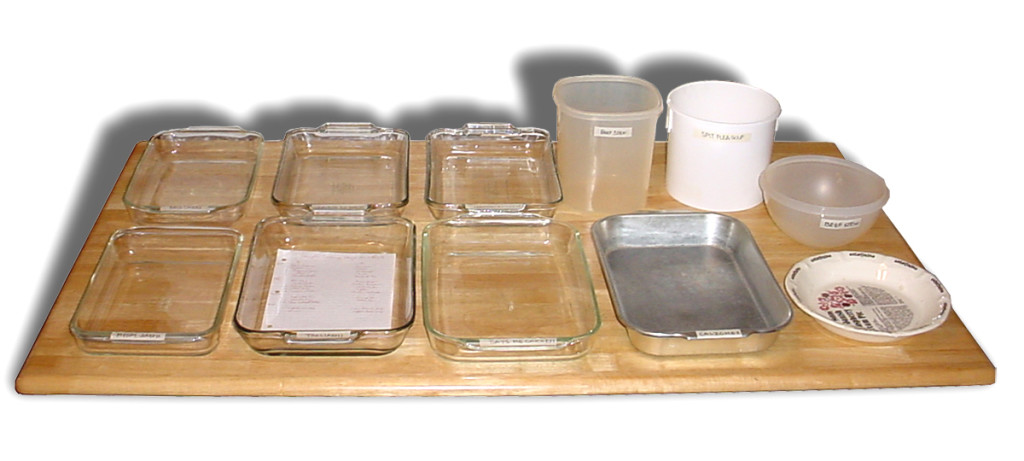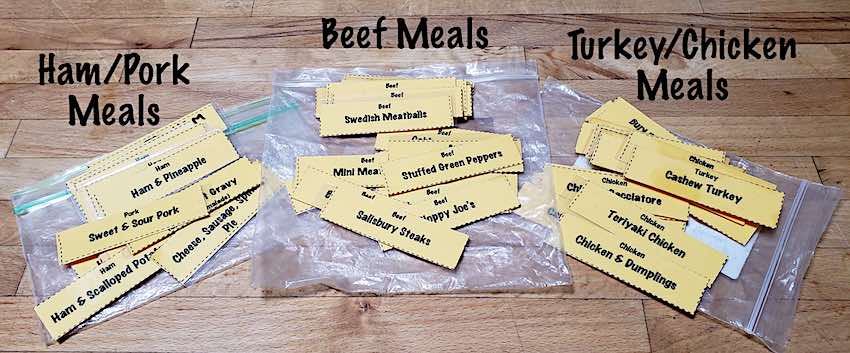Have you heard of Once-A-Month Cooking—where you prepare a month’s worth of meals in one day?
How about Bulk Cooking where you prepare large batches of several meals that are divided and stored for later?
Or lastly, freezer meals which are essentially the same as Once-A-Month and Bulk cooking, with all meals being stored in the freezer.
Do these ideas sound impossible or just too overwhelming? We’re talking about making meals super efficiently so that you can experience Cooking Freedom!
Well, Annette felt completely overwhelmed with the idea of Once-A-Month cooking when Steve first mentioned it to her more than 30 years ago. But today it’s a different story.
Stress Reduction Note: The principles that make this cooking method so helpful can be utilized to cook less often— or can be scaled down to do Once-A-WEEK cooking. So we hope you’ll keep reading and learn why cooking in bulk could help you save time and money.
Once-A-Month Cooking was a concept we learned about from a radio broadcast and later from the book “Once-A-Month Cooking” by Mimi Wilson and her friend Mary Beth Lagerborg.
What is Once-A-Month Cooking?
TABLE OF CONTENTS
- 1 What is Once-A-Month Cooking?
- 2 Why We Needed Once-A-Month Cooking
- 3 How We Do Once-A-Month Cooking
- 4 Baking Dishes and Storage Containers
- 5 Starting The Meal Assembly Process
- 6 Start Smaller – Do One Week of Bulk Cooking
- 7 2 Things That Limit Cooking Success
- 8 Our Young Adult Kids Cook at Home
- 9 Cooking for Singles, Seniors & Sharing
- 10 Cooking Day Changes over Time
- 11 Once A Month Cooking Wrap-Up
- 12 Cooking and Planning Resources
Once-A-Month cooking is a bulk cooking method where you assemble a number of dinner meals in one day to be frozen and then enjoyed throughout the next 30 days. Time and money are saved because common ingredients are sliced and diced at the same time and then distributed into the various meal containers.
For example, carrots, onions or potatoes may be used in 3 or 4 meals and are all cut up at the same time. Further, beef or chicken or some other protein source may be used in a number of meals and prepared in bulk.
The time savings with Once-A-Month cooking comes on a daily basis as you’ll have your dinner menu plan already established and the meal assembled, waiting in the freezer.
Money is saved by avoiding fast-food or take-out meals because dinner is already in the freezer.
But, before we talk about how we applied the concept of Once-A-Month Cooking to our lives, we’ll share why we found it appealing.
Why We Needed Once-A-Month Cooking
Saving money isn’t always the main motivation for doing the things we do. As we’ve aged (just slightly in 38 years of marriage), we’ve come to discover that time is ever becoming a more precious commodity.
We are constantly juggling our schedules, errands, work, chores, adult kids, grandkids and maybe even some recreation time.
Many of you have expressed the same concerns:
- How can I save time feeding my family?
- How can I work more efficiently meal prepping?
- Is there any way to squeeze more hours into my day so I can prepare delicious meals?
One way we’ve found to earn back several hours each week is Once-A-Month Cooking.
Don’t click off of this page yet, we know it sounds crazy, but it really does work. We’ll share why and how next.
Our Kids Were Young and We Were Tired
Years ago, Steve spent long hours driving to and from work and client appointments. While driving he listened to audiobooks and talk radio.
One day he heard a radio program extolling the wonders of cooking many meals in one day—Once-A-Month-Cooking (OAMC). Of course, like any devoted husband, he immediately came home and presented this great idea as something Annette ought to consider.
At that time, we had just two children, who were two and four years old.
Annette was working hard to care for their needs, and to keep our household running smoothly.
Remember, she barely knew how to boil water when we got married. So when Steve presented the idea, Annette’s initial reaction was to balk. But after some time thinking and considering the possibilities, she decided to give it a try.
She was completely overwhelmed during her first attempts to follow the instructions contained in the OAMC book. Now that she has modified the system to fit our family’s tastes and schedule, it’s much easier and more manageable.
How We Do Once-A-Month Cooking
After reading the book, Annette decided that many of the menus and meals they proposed were not for us. They weren’t bad, they just weren’t the type of meals she normally prepared. So being a motivated mama, she modified many of our recipes to work with the Once-A-Month cooking concept.
What Once-A-Month Cooking Accomplishes
The end result of our Once-A-Month Cooking day is 12 to 17 meals that are stored in the freezer and added to the monthly menu. The meals are usually pulled out the night before (or that morning—depending on the time of year) to defrost. Later in the day the meal is cooked or heated for dinner that night.
The end result of this process is more time on a daily basis for other things. Dinner is already prepared and in the freezer. As a result, meal prep time is minimized and family time is maximized.
We’ll describe the process we use below.
Planning The Menu
Annette plans a menu for the month based on the family’s schedule. She also looks at what cuts of meat we already have in the freezer, and items we have stocked in our pantry. We describe this in our article about meal prepping and menu planning. (Watch for a new article coming soon).
Normally, Annette will have somewhere between 12 to 17 meals that will be prepared on cooking day. “What”, you may ask, “I thought you were cooking for a month … like 30 days.” Keep reading …
The menu for the other days of the month consists of roasts, chops, leftovers, and other meals that are prepared on the day we eat them.
Her menu list usually consists of five beef dishes, six chicken or turkey, two or three pork or ham, and three vegetarian or miscellaneous meals. These vegetarian meals include: lentil vegetable soup, calzones, eggplant parmesan, or tofu with sesame and ginger stir fry.
Prepping Cooking Day The Night Before
Cooking day really starts the night before, when Annette pulls out a large slow-cooker and throws in a beef brisket or another easy meal.
According to the Once-A-Month Cooking book, this is done so that you start your day off with a meal already completed.
When beef brisket is on sale, we stock up. These make a wonderful meal of brisket with mustard and onion sauce, served over rice, pasta, or baked potatoes with salad or a vegetable side dish. (see the Brisket recipe here).
Another option is cooking a Corned beef (with the fat removed) and slicing it for use in Reuben sandwiches later on in the month. To round out this meal we serve the sandwiches with pickles and sometimes potato chips.
Baking Dishes and Storage Containers

The morning of cooking day, we clear the kitchen table and cover it with many 9-by-12-inch glass baking dishes, large plastic containers, and a variety of other baking dishes. You don’t have to use the same sized containers as us. Just choose containers that fit with your family meals.
Each is labeled with a piece of masking tape with the name of the meal scrawled in black marker. Steve likes to be creative and sometimes the labels are a little difficult to figure out—“Messy Joseph” for Sloppy Joes, “Chicken Farmer John” for Chicken Parmesan, and many others.
We even created laminated meal names so that Annette can put them in the appropriate baking dish or container. This helps her remember which meal goes in which container.

Creating A Task List for Bulk Cooking Day
Next, Annette makes a list of tasks that will need to be accomplished on cooking day.
The reason for the list is two-fold:
- To help her think through the various meals and combine as many tasks for similar items as possible.
- If she has three meals that use ground beef, all of the meat would be ground at the same time, and then divided for each meal. (Yes, in the past we did grind our own beef, but not so often anymore).
- De-Boning and dicing chicken or turkey.
- Washing and cutting carrots (for several meals)
- Peeling Onions for several meals (one of our kids would do this with a gas mask on), and prepping other veggies needed that day—peppers, celery, mushrooms, etc.
- and any other tasks for the day.
- For the kids to select tasks they wanted to help with.
When our kids reached the age of four, they participated in our cooking day. Even if all they could do was scrub veggies in the kitchen sink. they could participate. Abbey our youngest, was quite proficient at rolling meatballs when she was only 4 years old.
All kids who were eight-years-old and above choose tasks from the task list, they would like to work on throughout the day.
Many of the kids had favorite jobs. To ensure fairness and to prevent one child from selecting all of the “best” jobs, we allowed them to put their initials next to two tasks at the beginning of the day.
Then around lunch time the kids could select their final tasks for the day.
The kids knew, in advance, when the cooking day was scheduled and they would wake up early to pick the jobs they wanted.
Starting The Meal Assembly Process
Aprons on and knives at the ready, we dig in with a passion. This is the approximate order in which we tackle the tasks.
1) Veggies:
First, the veggies to be used in several recipes, are washed and chopped. Then divided into the appropriate amounts for the recipes that require them.
The youngest kids always were assigned to wash the veggies. It was an easy job and they loved playing with water. It didn’t matter if their clothes got soaked. Changing clothes was an easy price to pay for letting them get started learning in the kitchen.
2) Meat:
Next we start browning sausages for pasta sauce, or boiling a ham. These take some time, so they are started earlier in the day.
3) Poultry:
In the winter months, we use poultry meat that is already cooked. We usually cook one turkey during the month—remember, several are purchased at Thanksgiving time.
The turkey meat is first used for a sit-down turkey meal, then the remaining meat is frozen in plastic storage bags for use on cooking day.
In the summer months, we cook chickens in the slow cooker overnight, outside on our patio. This keeps the house cooler. And we start cooking day with meat that is ready to de-bone.
Cautions about Outdoor Cooking: Because we have a large fenced yard with large dogs in it, we don’t worry about predators (varmints or people) disturbing our food.
If you don’t have this luxury, try placing your slow cooker in your garage or another outdoor secured area. Just be sure it’s well ventilated and doesn’t create a fire hazard.
4) Simmering meals:
Next Annette starts to assemble meals that take a long time to simmer and cook. These include soups, stews, and her famous multi-generational pasta sauce—Ragu, eat your heart out!
5) Slice and Dice:
All the meat is sliced, ground or diced and put into the appropriate baking dish.
6) Assembly:
Once all the ingredients are chopped, sliced, cooked and sitting in their appropriate baking dishes or pots, the final assembly begins. BBQ turkey or turkey Parmesan are put together. Sauces are mixed for sesame chicken, ham and scalloped potatoes or chicken cashew.

7) Storage Crew:
Steve’s job is to seal each dish with plastic wrap or close-up the plastic container and carefully store the meals in the freezers. We stack the 9-by-12 baking dishes with a piece of Plexiglas or cardboard between them to make removal from the freezer easier. Labels on the sides of the dishes are always facing out so they can be easily read.
8) Cleaning Crew
Finally, everyone pitches in to wash all the pots, pans and other utensils used that day. We may even have to change the dishwater once or twice because there is so much to wash.
9) Easy Dinner that Night:
The night of cooking day, we will usually pick up a meal and bring it home. We try to keep the cost between $15 and $20 to feed the entire crew.
Start Smaller – Do One Week of Bulk Cooking
We know that this process may seem overwhelming to some of you. The idea of cooking 15 to 17 meals in a day is a lot of work.
Take it slowly. Try easing your way into this cooking method.
- Try planning for one week’s worth of dinners—somewhere between four to six meals. Then try cooking them in one day.
- If you’re successful, expand your planning to two or more weeks worth of meals.
2 Things That Limit Cooking Success
There are a few things that could hinder your ability to cook a lot of meals in one day.
1. Freezer Space: Lack of freezer space may limit the scope of your cooking day. Although if you put your meals into zippered freezer bags, you can fit a lot more into a smaller space.
Even if you can manage only a few meals in one day, you’ll save oodles of time during the week, especially if you have small children or both parents work outside the home.
2. Seasons of life: No matter what your season in life—single, young couple without kids, young family, family with teenagers, family with young adults, empty nesters or a senior couple—this concept can be beneficial.
If you have a newborn or a toddler and a newborn, you may need someone to help cook and someone to watch your children.
When our first two kids were under six years old, Steve’s job was to take them out of the house for the morning to play in the park.
They would come home, take naps, and we would finish up cooking.
As the kids have grown, they have become an invaluable part of the cooking team.
Steve would work on house projects and “borrow” one of the boys to work with him while the other kids were helping with the cooking tasks.
Yes, we think that it is important for boys to have basic cooking skills too. Keep reading to see how it has benefited them.
Our Young Adult Kids Cook at Home
Another amazing byproduct of doing bulk cooking was the empowering of our kids.
Now, as adults, they all have amazing kitchen skills. Some of them have become phenomenal cooks modifying and improving recipes or making up their own completely. It is amazing to look back and realize that their time helping to prepare meals for our family has equipped them now in their own homes.
Both of our daughters are the primary cooks in their home. And our three sons do some cooking in their homes, with one of them being the primary cook.
Cooking for Singles, Seniors & Sharing
If you’re a single or a senior, a 9-by-12-inch pan full of anything could last for weeks.
Consider making smaller portions using loaf pans or 8 inch x 8 inch square glass baking dishes. Another option is to share a cooking day with a friend and then split what you have made.
Working with someone else is always more fun, and you may just discover some new exciting recipes. Another advantage of having prepared meals in the freezer is being able to pull one out on a moment’s notice to help a family in need.
When Annette visited several single, retired women, she has discovered empty refrigerators. As they’ve talked, she’s heard the same story, that cooking for one person just isn’t worth the effort.
But, on a fixed income, eating out for every meal isn’t realistic either. Just as quilting bees are a great social and productive activity, getting a few friends together to cook, can be just as rewarding and delicious too.
Cooking Day Changes over Time
Our cooking days have changed over the years. In the past, we always did our cooking day on the last Saturday of the month, a day or two after our once-a-month shopping night.
As the kids’ activities and schedules changed, so did our cooking days. Sometimes we had to schedule them for a weekday when everyone was available.
Now that we’re empty nesters Annette usually cooks a double or triple batch whenever she makes a meal. The extra portions are put in baking dishes or other storage containers and frozen for use later in the month.

Once A Month Cooking Wrap-Up
No matter the day or how many meals you make, we’re convinced that the time savings you’ll enjoy will far outweigh the effort you put forth.
It takes time to master OAMC and to modify your favorite recipes to be freezer compatible.
Two Things We Learned:
- Pasta must be cooked molto al dente (slightly undercooked) before freezing. Why? If you don’t it will turn to mush when thawed.
- Potatoes also should be thoroughly cooked before being frozen. Why? Because they’ll turn black—we’ve learned the hard way.
Mistakes are inevitable, but once you’ve mastered this concept, you’ll wonder how you ever lived without it.
With Once-A-Month cooking, most nights, dinner preparation takes less than one hour. Because the main dish is prepared, all we need to add is veggies or salad. And some kind of starchy side dish such as pasta, potatoes, rice or corn.
The best part of Once-A-Month Cooking happens on those crazy days when Annette is running errands late in the day or involved with our kids and grandkids activities. Because she’s got meals in the freezer, with a simple phone call to Steve, dinner can be ready and waiting when she gets home.
Pass the pasta, let’s eat!
Here are some other cooking and money-saving options:
Cooking and Planning Resources
Here are some great resources that we use in our home:
- Download a free copy of our 2 Week Meal Planning Sheet (just give us your email address and we’ll give you the sheet.
- Buy a copy of “Cut Your Grocery Bill in Half.” This is our #2 on Amazon best-selling grocery book. With so many money-saving strategies that you won’t need to clip coupons.
- Buy our Grocery Forms Collection from our MoneySmart Printables Etsy Store for $6.98. It includes pdfs of the following forms:
- Grocery List
- Menu Planner
- Price Tracker
- Freezer Inventory


